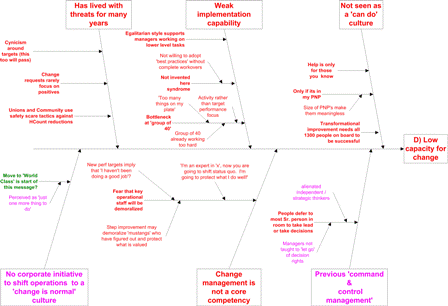Much of the change in organizations seems be unpredictable to those experiencing it. In those cases where you feel that you are the one instigating the change, it feels unpredictable to those experiencing it. The problem is that the methods and tools we use in the execution are just not up to dealing with unpredictable change.
This is what I believe to be true about organizations, processes and execution during times of unpredictable change and what we need to change.
- Processes move strategies, goals, outcomes or projects toward success. Execution processes are unpredictably subject to change from improvement to organization wide business process re-engineering (BPR).
- People within organizational structures are what drive the processes. These organizational structures are subject to unpredictable change.
- Before execution is complete, anything important being executed will be unpredictably affected by unpredictable process and organization change.
- These changes will directly impact team members working on our projects. With no warning, team members will no longer be able to meet their commitments. They will empathize, but won’t be able to help because they have new commitments.
- It is impossible to eliminate the unpredictability of change. Important execution involves individuals from multiple parts of the organization. No one effectively controls all the resources necessary to achieve success.
- Let’s call each uniquely managed part of the organizational hierarchy a ‘silo’. Each part uniquely controlled by another manager is also a ‘silo’. Each silo can make well intentioned changes to their process, roles, or organizational design. The overall organization may also make change to the complete organization. These changes appear to be largely unpredictable to people trying to execute based on the old ways.
- In execution we rely on managers from other silos to meet their commitments to provide;
- Resources for our projects, and
- Completed projects/ deliverables that are part of our project.
- This reliance on others and the knowledge that unpredictable change is the norm means that in most cases, the common execution method is based on Hope. We don’t control other managers’ resources. We don’t know whether they will successfully deliver a completed project for us.
Cultural norms in most organizations don’t permit detailed questioning by peers on how they’re going to achieve their commitments. Hope remains our most common method of execution.
- Hope is not a Method. To move from Hope towards Certainty in execution requires a new method different than what is being used today. People would like to know in advance whether other managers or team members are at risk of being able to deliver on commitments.
Until organizations choose to find a new method to execute strategies that provides full and continuous transparency on how commitments are being met, Hope will continue to be the execution method for most organizations.
The first five requirements for a new strategy 2 execution method are:
- A way to get everyone on the same page. There needs to be agreement on what is required to achieve the highest-level targeted outcome.
- Organization-wide transparency on progress towards the achievement interim outcomes regardless which parts of the organization structure are involved.
- A flexible linkage between execution processes and organization design that allows for continuous change. People in a changing organization may change reporting structure but not their alignment to targeted outcomes. People may change where they are in the organization, but it is the support of targeted outcomes that is their primary work responsibility.
- Shift to funding of targeted outcomes rather than projects. This allows outcome owners to shift funds between outcomes and their initiatives to ensure the most important initiatives are funded and have the needed resources. Funding of initiatives over outcomes keeps initiatives that have become less important, funded much too long.
- An on-going assessment of the health of the overall strategy to execution process. The organization needs to have a point of view on the areas of strength and weakness of the current strategy 2 execution process. Within their span of control, managers can create execution process improvements only when taking into consideration the impact on overall strategy 2 execution success.
Note:
- Execution sometimes takes place where all the resources are controlled by one person. You can assume that success should be higher in such cases. For example, CEO’s tend to control all the resources. Yet, CEO’s report that well over 50% of strategic program fail to meet their expectations.
- Some people would say that the method is based on Trust, not Hope. I would claim that it’s only Trust if you have worked with that person before and they have established a track record of meeting their commitments. Otherwise Hope is the method.
- Organizations will change; sometimes to the better (for you) and sometime for the worse. I doubt that any organizational change is good for everyone at the same moment in time.
- There are many strategies or projects in progress at any one time. It is impossible to plan process or organizational change to eliminate the impact of change for all strategic programs or projects that are ‘inflight’.




![Better Execution: Stick to Your Strategy? [Part 2]](https://www.strategy2execution.com/wp-content/uploads/2015/11/glacialstrategy3.jpg)

Leave A Comment